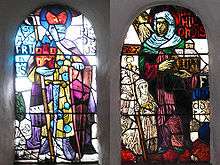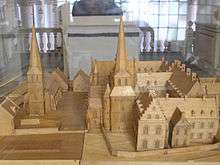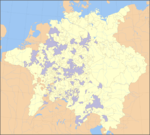Thorn Abbey
| Imperial Abbey of Thorn | ||||||||||
| Reichsstift Thorn (de) Rieksstif van Thoear (li) Rijksabdij van Thorn (nl) | ||||||||||
| Imperial Abbey of the Holy Roman Empire | ||||||||||
| ||||||||||
|
| ||||||||||
Territory of the Abbey of Thorn (blue), in the 18th century. The striped area of Neeroeteren was a condominium between Thorn and Liège | ||||||||||
 The Low Countries in the 16th century, showing the Abbey of Thorn in dark blue, at the north-eastern tip of the Prince-Bishopric of Liège (paler blue, centre) | ||||||||||
| Capital | Thorn (Netherlands) | |||||||||
| Languages | Dutch | |||||||||
| Government | Theocracy | |||||||||
| Historical era | Middle Ages | |||||||||
| • | Founded | ca 975 | ||||||||
| • | Gained Reichsfreiheit | 1292 | ||||||||
| • | Joined Council of Princes | 1793 | ||||||||
| • | Annexed by France | 1795 | ||||||||
| • | Awarded to Netherlands | June 9, 1815 | ||||||||
| Area | ||||||||||
| • | 1790 | 1.5 km² (1 sq mi) | ||||||||
| Population | ||||||||||
| • | 1790 est. | 3,400 | ||||||||
| Density | 2,266.7 /km² (5,870.6 /sq mi) | |||||||||
| ||||||||||
Thorn Abbey or Imperial Abbey of Thorn was an imperial abbey of the Holy Roman Empire in what is now the Netherlands. The capital was Thorn. It was founded in the 10th century; independence ended in 1794, when it was occupied by French troops. The abbey was reichsunmittelbar and belonged to the Lower Rhenish-Westphalian Circle.
The territory covered about 1.5 square kilometers with 3400 inhabitants in 1790.
Foundation

Details of the founding of the abbey are not clear. According to some sources, the abbey was founded by Countess Hilswind in 902 for herself and her daughter Beatrix. She donated the necessary land, which had been personal property, given to the Countess by King Zwentibold. Other sources claim a Benedictine double monastery was founded by Bishop Ansfried of Utrecht and his wife Hereswint in 925. A Romanesque abbey church was built in 992; some sources give this as the year the Abbey was founded.
Abbey structure


The collegiate women came only from the high nobility. It is likely that Thorn had belonged to the Benedictine order originally. It probably changed, however, in the 12th century, to a free secular ladies' abbey. In 1310, the secular cannons of the Abbey stressed their secular status and they claimed to never have been Benedictine.
In the 18th century, collegiate ladies were, in principle, required to reside in the Abbey all year, except for at most six weeks per year. However, for 600 florins, ladies could buy themselves free. In theory, free ladies were still required to provide six weeks of choral service; this was not always observed in practice. Some ladies held positions in several abbeys. This possibility of buying freedom appears to have been used frequently. Maria Josepha of Hatzfeld and Gleichen, for example, was a member of the abbeys at Thorn and Essen for 46 years. During this time, she resided in Essen Abbey for four years, but never in Thorn.
The abbey district contained a curia building for the Deachoness and five house for the ladies. In the 14th Century, a new Gothic Abbey Church was built. Some of the ladies built houses outside the abbey district.
History
The imperial immediacy of the abbey was confirmed in 1292 by King Adolf of Nassau. Under Emperor Maximilian I, the abbey was under the special imperial protection. In the imperial matriculation register at Worms, the Abbey was recorded as a reichsunmittelbar area. The matriculation duties, however, were transferred to the Counts of Lippe.
The abbey was a member the Lower Rhenish-Westphalian Circle and the Rhenish College of Imperial Prelates.
In the 17th century the governorship of the Spanish Netherlands sought to restrict the imperial immediacy. The abesses resisted these attempts successfully. In the 18th century, the abbess held the title of Princess. Several abbesses were simultaneously head of Essen Abbey.
The territory was conquered by French troops in 1794 and formally annexed by France in 1795. In 1815, the Congress of Vienna awarded the territory to the Kingdom of the United Netherlands.
Abbesses
- 982 - ?: Hilsondis (or Hilswinde?)
- 1010 - ?: Benedicta
- ? - ?: Godchildis
- ? - ?: Adelaide
- Before 1217: Elizabeth
- 1217 -: Jutta
- 1231-1269: Hildegond de Born
- 1273-1304: Guda of mountain race
- 1310-1337: Margaret of Bautersheim I.
- 1337: Isonde of Wied
- 1337-1378: Margaret II of Heinsberg
- 1389-1397: Margaretha III of Horne Perwez
- 1404-1446: Mechtilde of Horne
- 1446-1454: Jacoba of Loon-Heinsberg[1][2]
- 1454-1473: Else of Buren
- 1473-1486: Gertrude de Sombreffe
- 1486-1531: Eva of Isenburg
- Other ladies also claim during this period
- 1531-1577: Margaretha IV of Brederode
- 1577-1579: Josina I of Manderscheid
- 1579-1604: Josina II of the Mark
- 1604-1631: Anna of the Mark
- 1631-1632: Josina Walburgis of Löwenstein-Rochefort
- 1632-1646: Anna Eleonora of Staufen (simultaneously also Abbess of Essen)
- 1646-1647: Anna Catherina of Salm-Reiffenscheidt
- 1647-1690: Anna Salome of Manderscheid-Blankenheim (from 1690 to 1691 she was abbess of Essen)
- 1690-1706: Eleanor of Löwenstein-Rochefort
- 1706-1717: Anna Juliana of Manderscheid-Blankenstein
- 1717-1776: Countess Palatine Francisca Christina of Sulzbach (she was also Abbess of Essen)
- 1776-1795: Maria Kunigunde of Saxony (she was also Abbess of Essen)
References
- ↑ Derolez, Albert (1999). Corpus Catalogorum Belgii: Counts of Flanders, Provinces of East Flanders, Antwerp and Limburg. Paleis der Academiën. pp. 201–202.
- ↑ Verspaandonk, J. A. J. M. (1875). Het hemels prentenboek: Devotie- en bidprentjes vanaf de 17e eeuw tot het begin van de 20e eeuw. Hilversum: Gooi en Sticht. p. 9. ISBN 9030400641.
- Gerhard Taddey: Reichsstift Thorn, in: Ders (ed.): Lexikon der deutschen Geschichte. Ereignisse – Institutionen – Personen. Von den Anfängen bis zur Kapitulation 1945, Kröner-Verlag, Stuttgart, 1983, ISBN 3-520-80002-0
- Irene Crusius (ed.): Studien zum Kanonissenstift, Göttingen, 2001
External links
Coordinates: 50°10′N 5°50′E / 50.167°N 5.833°E

